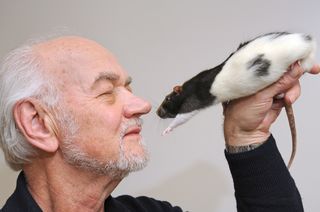Jaak Panksepp, the scientist who searched the deep roots of human emotion and there discovered the origins of play, died this past April 2017. The eminent research pioneer in the evolutionary neurobiology of human nature founded the new field called “affective neuroscience.” His discoveries in both the circuitry and chemistry of our social “Mind/Brain” are stunning in originality, amazing in reach, and promising for the future.
In a note to me this week, his friend and colleague Stuart Brown, M.D., play theorist, compared the stature of Panksepp’s investigations into the neural foundations of social joy with the paradigm-shifting discoveries of more famous twentieth-century scientists, such as Albert Einstein and Richard Feynman. As proof, Dr. Brown cited Panksepp’s half-century of discoveries, the books and more than 300 articles that culminated in “a grand unifying, neuroevolutionary theory about the brain substrates of the ancient mind that all mammals still share.”
I had the pleasure and the honor of interviewing Jaak Panksepp for the American Journal of Play several years ago. In this searching conversation, he reached back into the history or our species to find that over the long evolutionary haul, play has promoted social bonds and nourished social learning. Looking back on individual life histories, more specifically, he observed that optimal brain development depends on healthy play experiences in early life. And as the interview turned autobiographical, he looked toward his own remarkable early experiences to highlight an important role for play.
Born in Estonia, Panksepp was not yet a year old when, in 1944, his family fled west to escape the invading Russian Red Army. After the Allied victory, the family lived in a series of displaced persons’ camps in Germany until 1949. He remembered the internment not for the crowding and deprivation that so affected adults but as a “deceptively care-free” interval sustained by continual rough-and-tumble with age-appropriate playmates. With adults otherwise preoccupied with the exigencies of camp-life, the “footloose kids” who abounded there were left largely on their own to play and range and rummage freely. He recalled skinning his head while scrambling over ruined tanks and wrecked army trucks, and he remembered joining the mock battles where kids substituted snowballs with clods of earth that had been churned up by explosions. The adult scientist open-mindedly regarded these episodes of free play as a “fun way to test the social realities into which one was born.” And he noted how this testing highlighted the evolutionary function of play—finding out “what is fun and fair or not fair on the field of life.” The twin experiences of hardship and liberty that defined his early life granted Panksepp a lifelong habit of flexibility that extended to his scholarship and research.
A constitutional open-mindedness led, accidentally, to one of his most important, simple, and ingenious discoveries—that rats, like us, laugh when tickled, even though we humans and those rodents last shared a common ancestor 75 million years ago! (I wrote about the discovery of rat-laughter in the very first column in a “Play in Mind” series.) And he made this discovery even though rats chirp in the ultrasonic, well above and beyond the range of human hearing. To overcome this sonic obstacle, Panksepp and his enterprising graduate student, Jeff Burgdorf, recorded the lab animals with detectors that could listen to the squeaks of echolocating bats. And, what do you know, rats’ tickle-giggles proved to be the very same giggles that they giggled while wrestling—their favorite kind of rough-and-tumble play.

That Panksepp could have been free to have discovered that rats and humans shared a 75-million-year-old impulse to titter while at play itself owed to a very special and fortunate circumstance. In the twentieth century, most experimental psychologists followed the radically narrowed research agenda of John B. Watson, B.F. Skinner, and other behaviorists, who were interested in stimulus and response and prediction and control of learned behavior. (Famously, they ran rats through mazes and timed their learning curves.) Jaak Panksepp, on the other hand, was most interested in natural behaviors and social transactions that arose from animals’ original equipment that evolution had bestowed upon them—the instinctual and apparently emotional prompts to action that hold survival value in the real world, generation after generation.
And whereas the behaviorist ascendency that ruled in faculties at the best-known university psychology departments disallowed research into “experienced emotionality” and discounted “experience,” at the free-wheeling Bowling Green State University, where Panksepp held a professorship, no such bullying prevailed. Escaping what he called the “enforced silence” of behaviorist research left him free to investigate motivations and mental processes in animals with complex brains. And so, he turned his investigation to those fundamental “primary-process mechanisms,” basic socioemotional talents and built-in capacities, and ancient feeling states that he termed in capital letters, SEEKING, RAGE, FEAR, LUST, CARE, PANIC/GRIEF and (to our point) the deep positive emotion and ancient adaptive behavior, PLAY.
Panksepp believed that PLAY was the most complex of the positive emotions and the most “recent” of them as well—though proximity is measured in scores of millions of years over the sweep of evolutionary history. Our loyalty to the human prospect counsels us to think that play is primarily about thinking—a conscious cognitive process. Thinking seems uniquely human, and after all, we need only look no further than the elaborate rules and laws that referee our competitive games for proof. They are so cognitively complex, in fact, that we sometimes adjudicate them with instant replay. But Panksepp’s investigations of the behavior of decorticated rats revealed that play impulses emerge primarily not from the neocortex, the latest addition to our thinking human brain; but actually, wild and playful impulses originate from deep within the ancient brain-stem.
This primordial impulse to play thrived and deepened with social evolution. Panksepp discovered, for example, how rats that had been isolated for a time played with a special verve when rehoused with their rodent society. And he found that rats deprived of nurture and playful experience in their infancy grew up as particularly unsuccessful adults who were unable to recognize threat from play-signaling and were awkward at or even incapable of mating. Both emotional deficits would have threatened their survival as well and, consequently, their ability to pass on their genes in the natural world.
We humans value our separate status, our cognitive sophistication, and prize our ability to think; we invoke the self-congratulatory moniker homo sapiens—wise men—and term modern humans by the even more complementary homo sapiens sapiens to separate ourselves from other mammals who have not constructed skyscrapers, invented government and codified legal systems, or written popular novels. But in-group, sentimentality turns to arrogance when we discount our connection to the mammalian inheritance. Nearsightedness of our remote evolutionary past adds up to danger in the pressing present. We put ourselves in social and emotional peril when we ignore the ancient impulse to play. Panksepp, ever the visionary and ever the practical thinker, imagined playgrounds as play “sanctuaries,” antidotes against current trends toward playlessness.
Happily, Jaak Panksepp made positive states like playfulness, laughter, love, and joy the legitimate subjects of neuroscience research. His interest in the other deep emotions, such as anger and dread, longing, and sadness and anxiety, helped him build bridges to other emerging psychotherapeutic sciences that included neuropsychoanalysis and interpersonal neurobiology, which concern themselves with human suffering.
As his ideas today inspire a broad range of thinkers, including philosophers, psychiatrists, and psychotherapists, it should not come as a surprise that Panksepp’s understanding of neurochemistry begins to point in a practical direction—to treatment. So far, the modern drugs that treat psychic ills came to us as pure accidents, by-products and side-effects of other medicines. But Panksepp’s recent research with Jeff Burgdorf and Yorum Yovell has aimed directly at cracking the neurochemistry of neuropsychiatric disorders like depression and anxiety. The understanding of the chemistry of the Brain/Mind that Panksepp pursued may someday result in a profoundly new pharmacology equipped to revolutionize treatment of the dark discontents of our bright modern age.




